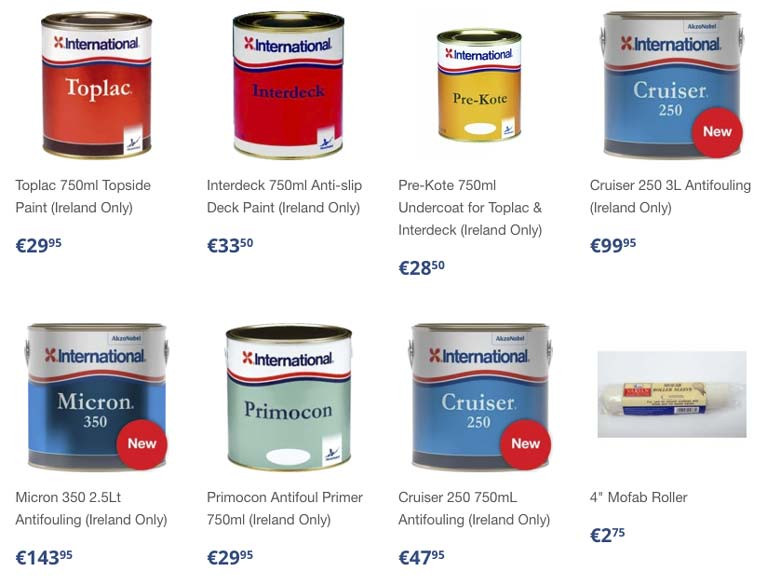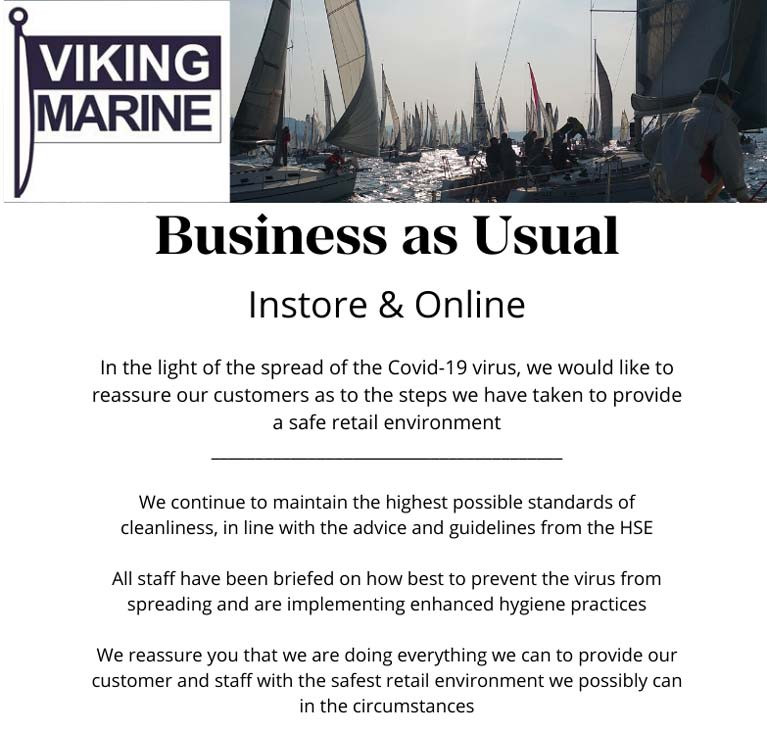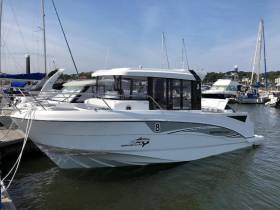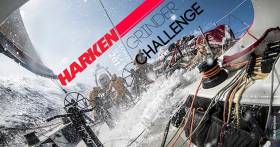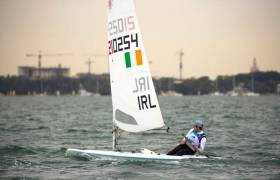Displaying items by tag: Viking marine
Viking Marine Make Daily Deliveries to Dun Laoghaire Yacht Clubs
Viking Marine is happy to deliver primer, paint, varnish and supplies to any of the local clubs as work starts on boats over the weekend in anticipation of next month's Summer sailing season.
To avail of this service simply contact Viking Marine in the shop and we will have your order delivered to your club in Dun Laoghaire, Viking's Ian O' Meara told Afloat.
Click here for paint range and phone 01 280 6654
For deliveries outside of Dun Laoghaire contact us at the shop and we can arrange next day delivery anywhere in Ireland.
Viking Marine is Open St Patrick's Day 1 pm - 5 pm
Viking Marine: Business as Usual In Store & Online
In light of the spread of the Covid-19 virus, Viking Marine at Dun Laoghaire Harbour would like to reassure our customers as to the steps we have taken to provide a safe retail environment.
We continue to maintain the highest possible standards of cleanliness, in line with the advice and guidelines from the HSE.
All staff have been briefed on how best to prevent the virus from spreading and are implementing enhanced hygiene practices.
We reassure you that we are doing everything we can to provide our customer and staff with the safest retail environment we possibly can in the circumstances.
Bite-Sized Tips From Viking Marine For Staying Warm On Water
When it comes to safety and warmth on the water, we all know how important our gear is, and we wouldn’t go sailing in summer without water and suncream.
But we often forget the importance of keeping our blood sugar up to stay warm on the water during the winter.
Making sure you have a snack on board is crucial in keeping warm on the water over the winter, even if you’re only out for a short time.
Bananas, protein bars, chocolate and sandwiches are all great grab-and-go options, whether you’re heading out for a leisurely sail or a Turkey Shoot race.
Winter swimming is also a growing trend, and Viking Marine has responded with a broader sea swimming range that includes dry robes and Zone 3 swim hats, Apollo Goggles and a full range of winter swimsuits now in stock.
And be sure to check out Viking Marine’s online clearance store, with up to 50% off both coastal and technical gear.
Off the back of what they declare was their best ever year for sales of Beneteau outboard boats, Irish brokers BJ Marine were recently in attendance at the French builder’s global dealer conference in Valencia to get a special look at its fully Suzuki-powered range.
General manager James Kirwan told Afloat.ie: “The growth of the range of outboard boats inspired us to invest in our first ever Irish Barracuda Tour qualifier, an event that also supported by Viking Marine, our Suzuki partner in Ireland.”
Beneteau’s outboard range covers the Antares, Barracuda and Flyer models, from six metres up to the new Antares 11 which will be unveiled this winter.
“In particular, the Antares and Barracuda ranges offer the perfect versatility for use in Irish waters where rapidly changing weather and sea states are regular events,” Kirwan said.
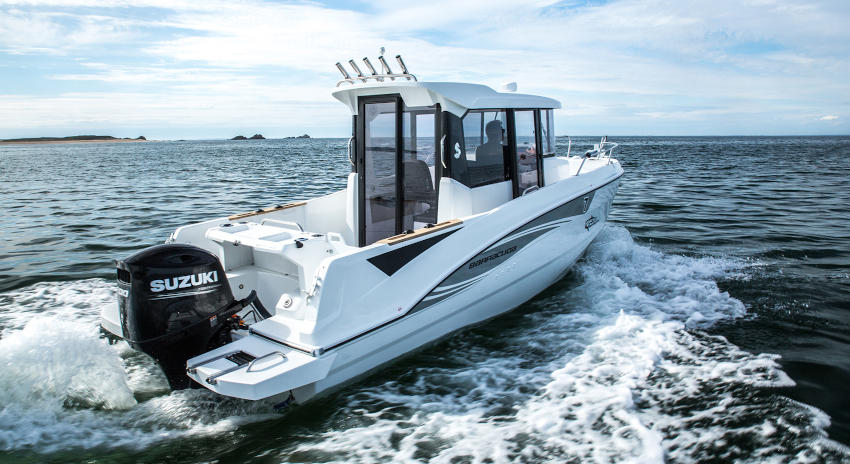 Beneteau Barracuda with a Suzuki DF200AP outboard
Beneteau Barracuda with a Suzuki DF200AP outboard
Suzuki has been the outboard supplier of choice for Beneteau since 2013 and the French builder says its partnership continues to go from strength to strength.
Five Suzuki-powered boats were on the water in Valencia ready for dealers to test — including the new Flyer 10 and 7.
“We are very proud to work with and partner Beneteau,” said Daisuke Kawatari, general manager for Suzuki Motor Corporation’s European liaison office.
“Our partnership is a strong one and we are looking forward to taking it to the next level in order to continue to deliver the ultimate boat/engine packages for our customers.”
Have you got what it takes to beat the best? Harken grinder pedestals are found on some of the most exciting race boats in the world, raced by sailors at the top of their game! But have you got what it takes to top our Viking Marine leaderboard this weekend?
Viking Marine has brought the Harken Grinder Challenge to the ICRA Championships on Dublin Bay this weekend.
Prizes include Viking Marine gift vouchers for First Time places for Ladies and Men on both Friday and Saturday.
You will find the Viking Marine Harken Challenge on the forecourt of the RSGYC Friday and Saturday after racing.
So get your name up on that leader board and the winning prize is yours.
Viking Marine rules of 'pure fun' and 'good sportsmanship' applies to this event. That will be interesting!
After the Rio Olympics, the International Laser Class Association changed it's class rules to allow the use of digital compasses. The rule now is that 'Electronic, self-contained, digital compasses using only magnetic input are permitted.'
In conversation with Viking Marine Ambassador Finn Lynch before he headed off to the European Championships, the Tokyo 2020 campaigner discussed how he now uses the Raymarine TackTick micro compass.
"The digital compass takes away a lot of guesswork from Laser sailing"
'I find this to be a game changer for overall performance in Laser racing. At start time I use the compass for checking the exact degree of line bias and also it's a great tool to see what shift you are in straight off the line. Apart from making tacking on the shifts very easy, I also love the digital compass for straight out of the bottom mark for seeing what shift you are in, it makes a very stressful area of the course more simple'. And when asked about its role in winning races these were his parting words - 'Overall, the digital compass takes away a lot of guesswork from Laser sailing and allows you to put more attention to more important things, like making the boat fast!!
The Raymarine range along with others are available in the shop at €379.95 and online here
The first Irish Coastal race of the Viking Marine ISORA Coastal Championship 2019 took place on the 18th May with a starting time of 10.00. 21 boats from the entry list of 22 came to the start line in Dun Laoghaire.
Setting the course was difficult for the Sailing Committee as very light northerly winds were forecast for the race. To add to the difficulty, strong spring tides were also predicted. With this combination, it was decided that the course should try and accommodate the tide by heading north at the start and south later in the race. It had been hoped that the course would be 40 miles by heading to South Burford, Lambay Island and back by the Kish Light. Instead, Lambay was substituted by using Howth Yacht Club’s “East” racing mark and North Kish Cardinal mark was substituted for the Kish Light.
When this course was first published Dublin Port requested that South Burford not be used as it meant that the fleet would be crossing the TSS (Traffic Separation Scheme) at South Burford. To comply with their request, ISORA has now created a permanent virtual mark, “ISORA Dublin” mark, just south-east of South Burford. It is now intended that this virtual mark will be used for all future ISORA races, acting as a Turning mark for boats entering or leaving Dublin Bay. It is also proposed that all TSS’s will be no-go areas in future races.
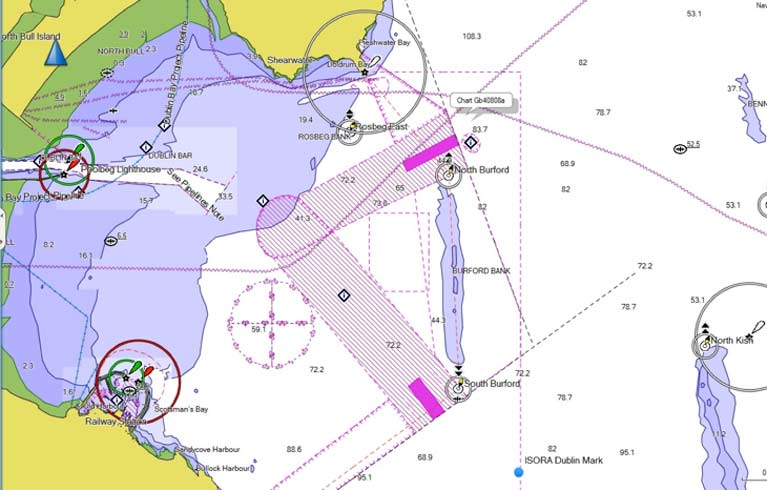 The above course provided a 30-mile race
The above course provided a 30-mile race
The wind at the start was as forecast – 4-7 knots north-easterly. The start at 08.00 was provided by NYC’s Barry MacNeaney and Grainne Ryan at the DBSC’s Pier Mark.
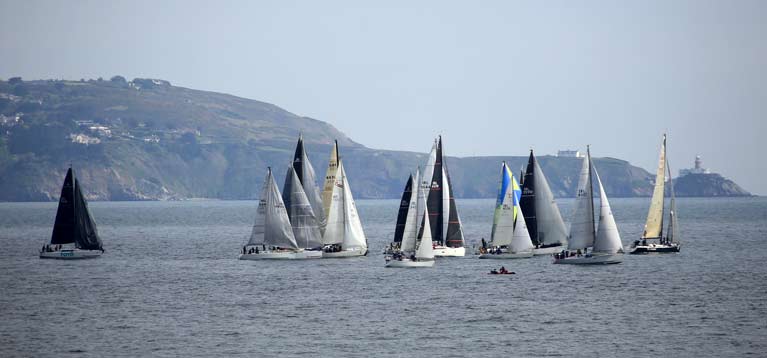 A packed 21-boat start line in a light easterly for the Viking Marine Coastal Race start on Dublin Bay Photo: Afloat.ie
A packed 21-boat start line in a light easterly for the Viking Marine Coastal Race start on Dublin Bay Photo: Afloat.ie
 Five minutes after the start Frank Whelan’s “Eleuthera” (second from right) was the first to break from the pack on Dublin Bay Photo: Afloat.ie
Five minutes after the start Frank Whelan’s “Eleuthera” (second from right) was the first to break from the pack on Dublin Bay Photo: Afloat.ie
The fleet of 21 boats slowly moved east off the start line in a tight reach towards the new ISORA Dublin mark. Frank Whelan’s “Eleuthera” was the first to break from the pack but was soon overtaken by Ben Shanahan’s “Ruth”, Chris Power-Smith’s “Aurelia” and Lindsay Casey’s “Windjammer”. Just south of these, Vincent Farrell’s “Tsunami” was sneaking along toward the first mark.
“Ruth” and “Aurelia” rounded the first mark and hardened onto a beat north toward HYC “East” mark. In an effort to minimise the effects of the tide and to seek stronger winds many of the fleet tacked out to sea while the remainder stayed close to the land. It was on this leg that the wind started to play tricks. On the outer east side of the course, the wind was northeast and varying while on the inside of the course the winds was north-west and strengthening. At one stage boats on each side of the course were sailing the same heading while on opposite tacks!! The stronger winds on the inside were sufficient to counteract the strong tides against those boats close to Howth Head and these boats gained hugely.
These wind conditions changed the whole dynamic of the race and allowed the smaller boats to take control. “Eleuthera” rounded the HYC East mark first followed by George Sisk’s “WOW” and then by “Ruth”. However, “Windjammer” was close by to the leading pack.
The leg to North Kish was a run south in the ebbing tide. When the first of the fleet rounded North Kish they had to beat for the ISORA Dublin turning mark and towards the finish line while the boats further back took advantage of another massive wind shift and they had a fast reach past the turning mark to the finish line.
While “Eleuthera” took line honours, “Windjammer” took the Overall win and Class 2. Second place went to another Class 2 boat, Leslie Parnell’s “Black Velvet” and Class 1 “Ruth” took third place. Class 0 boats only managed to get on the leader board at 9th position with Paul O’Higgins' “Rockabill VI”. Sean Hawkshaw’s “Wardance” took Silver Class.
After the race, many of the crew headed to the National Yacht Club for the usual “Apres Race”.
On the same day, a coastal race was held in Pwllheli. At this stage in the series Andrew Hall’s “Jackknife” is just ahead of “Rockabill VI” in the leadership table for the Wolf’s Head.
The Race Organiser for Race 4 was Grainne Ryan. Anita Begley was Safety Officer. The finish was automatically recorded using the YB trackers.
The next race is the second Offshore of the season and takes place on Saturday 25th May with an 08.00 start from Dun Laoghaire. The original race schedule was for the start to be in Holyhead and finish in Dun Laoghaire but Holyhead was unable to accommodate the start. The start and finish is now in Dun Laoghaire and it is hoped that the race will be 60 miles.
Full results and the YB tracking of the race are on the ISORA website here
Viking Marine's ISORA Coastal Series Starts on Saturday
Viking Marine will sponsor the ISORA Coastal Series again this year for the third year running writes Ian O'Meara.
I have always loved offshore sailing. To this day, I remember my first offshore in 1980 onboard Barry O'Donnell's Oyster Yacht 'Sundowner'. Great sailing and great fun brings out the best in all of us.
As Afloat previously reported, the Coastal series kicks off this weekend and I will be onboard Paul and Finnoula O'Higgins' JPK 1080 'Rockabill VI'.
The 2019 series promises to be an exciting one with ISORA and Afloat keeping everyone up to date on racing Instructions and results.
Wishing everyone a great series and stay safe. On that note, Spinlock has launched the new Deckvest Vito Offshore 170n Hammar Lifejacket at €260.00 and with harness €289.95
 Deckvest Vito Offshore 170n Hammar Lifejacket
Deckvest Vito Offshore 170n Hammar Lifejacket
If you need any assistance with safety equipment for the Coastal Series please do pop into us.
Editor's note: It's clear that Ian O Meara's love for Oyster Yachts continues, this year O'Meara was appointed the Oyster Representative in Ireland
Before setting off for next week's World Cup Regatta in Genoa, Italy, Finn Lynch gives some thoughts on his great result last week at the Palma Regatta where the Viking Marine Ambassador placed fourth overall.
'I meant business in Palma. The only notable difference in this regatta to other regattas in the past was between my ears! Before the race, I created some strategies with some Irish Sailing coaches and my sports psych to help get me into the zone. It worked.
"I'm excited to have made a leap forwards & pumped to try back it up next week in Genoa"
In Laser sailing your focus needs to be constantly changing from speed, tactics, strategy, checking for the jury, risk management, thinking ahead, among other things and when you focus on one aspect at the wrong time you lose. An example might be if you are deciding whether you should tack or not and you hit a bad wave and lose a boat length that might cost you a lot later on in the race.
This makes Laser sailing so hard but so rewarding when things come together.
I'm excited to have made a leap forwards and pumped to try back it up next week in the Genoa World Cup.'
Looking for a Summer job? Dun Laoghaire's Viking Marine are recruiting right now for the summer season for its Dublin Bay based Chandlery.
Viking Marine is looking to recruit experienced sailing enthusiasts to work for the summer sailing season in our Dun Laoghaire store.
Interviews will take place during April before exams and job to start early June.
If you are an experienced sailor with a sound knowledge of both dinghy and yachts and have worked in a 'customer interfacing space' contact Viking.
To apply for a position please send your CV with covering letter to: [email protected]



























